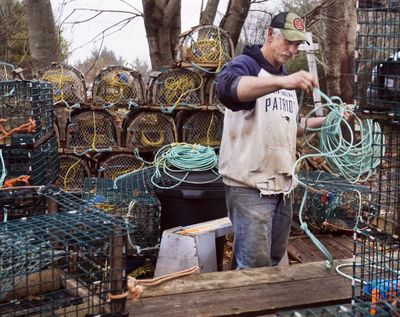Curse of the ‘ghost trap’
Marine biologists study ill effects of lost lobster gear

PORTLAND, Maine – Beneath the cold ocean waters off the coast of Maine, the nation’s lobster breadbasket, lie hundreds of thousands, perhaps millions, of old wire lobster “ghost traps.” Lost over the years to storms, boats – even the knives of fishermen – many of the traps continue catching lobsters.
Marine biologists say lost and abandoned lobster, crab and other fish traps plague coastal waters around the globe, putting pressure on a number of already-stressed fish populations. In U.S. waters alone, millions of dollars’ worth of marketable seafood is lost each year.
Lobstermen this winter will grapple up gear from selected spots in the first large-scale study of ghost traps along the Maine coast. Nationwide, other studies are focusing on lost traps off the Pacific, Atlantic and Gulf of Mexico coasts.
“It would be very interesting if we could drain the ocean and look at what’s down there,” said Holly Bamford, head of the National Oceanic and Atmospheric Administration’s Marine Debris Program. “We might be surprised.”
The extent of Maine’s ghost-trap problem isn’t fully known, but lobstermen say they sometimes recover traps that contain skinny lobsters – ones that appear to have not eaten – or shells from lobsters that have starved and withered away to nothing or been eaten by other lobsters.
Most lobstermen feel it’ll get worse with a new federal regulation requiring them to use a certain type of rope on their gear. The rope, they say, is prone to breaking and will result in even more lost traps.
Fishermen have been losing and discarding equipment for as long as they’ve plied the world’s seas. But the range and impact of that refuse has grown in the past 50 years as fishing has increased, especially with more durable, non-biodegradable equipment.
“Ghost fishing” studies are under way or recently completed along all U.S. coasts. They include looks at Dungeness crab traps in Alaska, Washington, Oregon and California; blue crab and sea bass traps off North Carolina; blue crab traps in the Chesapeake Bay and the Gulf of Mexico; spiny lobster traps in Florida; and fish traps in the U.S. Virgin Islands.
Other studies have looked at the impact of lost fishing nets found in Puget Sound in Washington and off the northwestern Hawaiian Islands, where more than 600 tons of nets were collected.
Two winters ago, Ian Lussier of Owls Head grappled for lost traps with another lobsterman in Penobscot Bay and recovered several hundred traps in depths of 100 to 400 feet, he said. Some had tags showing they were owned by lobstermen who hadn’t fished in more than a decade. Some traps were wooden, which haven’t been used for the most part for 25 years.
How much lobster the traps are catching is almost a “non-issue” for Lussier because he believes so few are caught.
The bigger issue, he says, is a new federal regulation that aims to protect endangered North Atlantic right whales by outlawing use of floating rope that connects lobster traps on the ocean bottom and sometimes entangles the whales.
Worldwide, concerns about lost gear are growing.
Besides fish and shellfish, lost nets and traps have been known to snag whales, seabirds, turtles and other animals, the Food and Agriculture Organization of the United Nations reported this year.